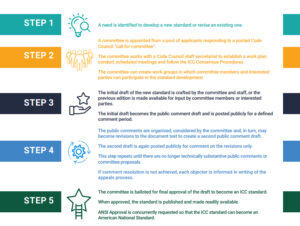
Code Council standards development process primer
While the International Code Council is best known for the development of model building codes, it also has a growing suite of standards
While the International Code Council (Code Council) is best known for the development of model building codes — the International Codes (I-Codes) — the Code Council has a growing suite of standards. As most I-Code users know, the codes often point to standards that are not developed within the code development process but provide further direction or specialized information. Some of those standards are developed by the Code Council.
This Primer provides information on the standards development process — specifically for stakeholders interested in getting involved in the Code Council’s standards activities.
Standards are typically developed under the direction of a standards development organization (SDO) that has specialized expertise and a documented process that follows key principles. In the U.S., many standards are developed by an SDO accredited by the American National Standards Institute (ANSI). ANSI has identified essential requirements to guide standards development. These requirements include openness, balance, due process, consensus and a right to appeal. These requirements have also been recognized by the federal government.
From these essential requirements, SDOs develop consensus procedures that guide their processes for developing standards and set the expectations for anyone participating in the standards development process. At the Code Council, the standards development process is documented in Council Policy 12 (CP 12) and the Code Council’s Consensus Procedures. The Code Council’s Consensus Procedures undergo periodic revisions to comply with the essential requirements and are written such that standards can be developed in the most time-efficient manner. The Code Council’s current Consensus Procedures were approved by ANSI in August 2021.
Council Policy 12 covers the process for beginning work on a new standard, including considerations on the needs the standards will fulfill and any existing standards on similar subjects. As noted in CP 12’s purpose statement, “In order to accomplish the ICC mission of providing a coordinated and comprehensive set of model codes as well as regulatory documents supporting the built environment, it is necessary to assure the availability of acceptable standards. This policy gives general criteria regarding the development and maintenance of standards by the ICC. This policy is intended to work in concert with the ANSI-approved ICC Consensus Procedures, which regulate the development and update of ICC standards.”
The ICC Consensus Procedures outline the roles and responsibilities of the Code Council Board of Directors and the standards development committees. Standards development relies heavily on committees to determine the final content of the standard. The Consensus Procedures cover the formation of standard development committees, including the requirements to demonstrate balance across different interest categories. The Code Council has identified nine interest categories that should be considered in the formation of committees: manufacturer, builder, standards promulgator/testing laboratory, user, utility, consumer, public segment, government regulator and insurance.
In addition, the Consensus Procedures include requirements for the conduct of meetings, the required steps in the standards development process (including when and how public input must be sought), and the procedures for appeals.
Starting a new standard
 Standards are generally developed to support consistency in a product, process or outcome. The Code Council’s portfolio of standards address important aspects of the built environment — from the design of storm shelters to bleacher safety and rainwater collection. The Code Council also partners with other organizations to develop standards consistent with the Code Council mission, including RESNET and the Home Innovation Research Center. The list of standards developed by the Code Council can be found here. But how are these standards born?
Standards are generally developed to support consistency in a product, process or outcome. The Code Council’s portfolio of standards address important aspects of the built environment — from the design of storm shelters to bleacher safety and rainwater collection. The Code Council also partners with other organizations to develop standards consistent with the Code Council mission, including RESNET and the Home Innovation Research Center. The list of standards developed by the Code Council can be found here. But how are these standards born?
At the Code Council, the decision process on starting a new standards activity is outlined in CP 12. Recommendations to develop new standards can come through either the Codes and Standards Council or the ICC Board of Directors. However, the board makes the final decision on whether to proceed. Per CP 12, the decision should be based on the following factors:
- The lack of regulatory documents necessary to govern a given subject;
- Requests for standard development;
- Review of existing standards on similar subjects;
- Willingness of existing standards developers to work with the Code Council in the joint development of an ICC standard or to co-brand an existing standard;
- Review of existing standards for compatibility with the I-Codes; and compliance with Council Policy 28 (CP 28) Code Development; and
- Review of timeliness, update frequency, responsiveness, adequacy of coverage and consensus nature of an existing standard.
Once the board determines if a standard should be developed, a formal title, purpose and scope are developed to set the parameters of what the standard will cover. The title, purpose and scope are then typically sent to ANSI through its Project Initiation Notification System (PINS). The submitted PINS information is then published in ANSI Standards Action to give public notice and allow for comment.
Any interested party can submit comments or request information from the SDO on the project within 30 days of the PINS publication. The Code Council will also publish information on the initiation of a new standard (either in a Building Safety Journal standards update, on social media or via an ICC Pulse notice).
Once the window for comments on the PINS is closed and any comments received are addressed, the solicitation of members can proceed.
Seating the committee
Development committees are at the core of the standards development process. They are responsible for the development of standard content, reviewing public comments and determining what is ultimately included in the standard. The makeup of the committee is also where the essential requirement of balance is achieved.
 Either when a new standard receives approval to begin development or when an existing standard is up for revision, a committee must be established. The process for soliciting committee members and seating the committee are outlined in CP 12, Council Policy 7 (CP 7) and the ICC Consensus Procedures. The first step in this process is the issuance of a call for committee members. This call is widely disseminated through the Code Council outlets, including on a dedicated webpage where open committee calls are posted. The application for committee membership is also posted on this page. The call may also be posted in ANSI Standards Action. The call is open for at least 30 days.
Either when a new standard receives approval to begin development or when an existing standard is up for revision, a committee must be established. The process for soliciting committee members and seating the committee are outlined in CP 12, Council Policy 7 (CP 7) and the ICC Consensus Procedures. The first step in this process is the issuance of a call for committee members. This call is widely disseminated through the Code Council outlets, including on a dedicated webpage where open committee calls are posted. The application for committee membership is also posted on this page. The call may also be posted in ANSI Standards Action. The call is open for at least 30 days.
When submitting an application, applicants may identify an alternate for participation on the committee should the primary representative be unable to attend a committee meeting or needs to withdraw from the committee.
Once the application period closes, the Codes and Standards Council reviews the applications and makes a recommendation to the Code Council Board of Directors based on the requirements outlined in CP 7, CP 12 and the ICC Consensus Procedures. The board makes the appointments to the standard development committee, including the designation of a chair and vice chair.
Per the Consensus Procedures, committee membership “shall be sufficiently diverse to ensure reasonable balance without dominance or imbalance by a single interest category, individual or organization. No single interest category should constitute more than one-third of the membership of any committee.” Interest categories identified are:
- Manufacturer
- Builder
- Standards promulgator/testing laboratory
- User
- Utility
- Consumer
- Public segment
- Government regulator
- Insurance
Applicants who are not appointed as voting members of the committee are still encouraged to be involved. The staff secretariat maintains a list of interested parties who receive notices of meetings, the release of public comment drafts and other important committee activities. Interested parties may also engage through workgroups.
Once the committee is seated, they begin work on the content of the standard.
Developing the initial draft
 At its core, standards development activities are aimed at producing a document that outlines specific requirements or procedures. Over the course of the standards development process, the draft standard will go through several rounds of revisions before it is finally approved. Some of that editing is done internally in the committee as its members work to develop the best way to express a requirement or as they hash out what is the minimum accepted practice. Additional editing is done based on the comments received from the public.
At its core, standards development activities are aimed at producing a document that outlines specific requirements or procedures. Over the course of the standards development process, the draft standard will go through several rounds of revisions before it is finally approved. Some of that editing is done internally in the committee as its members work to develop the best way to express a requirement or as they hash out what is the minimum accepted practice. Additional editing is done based on the comments received from the public.
Once the standards development committee has been seated, work begins on preparing an initial draft of the standard. For existing standards that initial draft typically starts with the prior edition. For new standards, the committee or the secretariat often starts from scratch — although they may look to other documents (guidelines, research papers, potential reference standards, case studies, etc.) for guidance.
Depending on the scope of the standard, workgroups may be established to develop content on specific aspects of the standard. These workgroups can be formed just for the initial draft or may be used throughout the standards development process.
Once the committee is satisfied with the initial draft, it is put out for public comment. The initial draft is posted on the Code Council’s webpage and the public comment period is open for at least 30 days. Comments on the initial draft are received in legislative format (strike through and underlines indicating recommended deletions or additions, respectively). Once the comment period closes, the public input is compiled and presented to the committee.
The committee considers each comment and determines how to address it. Once a path forward is determined, the comment submitter is notified and has 30 days to respond, either accepting the disposition, providing additional information requested by the committee or further making the case in favor of their comment. Comments received during this 30-day period may be dealt with in the next draft.
Once comments on the initial draft are addressed, the committee prepares the first draft.
Public comment drafts, responses and committee voting
Once all the comments on the initial draft are received, the development committee deliberates on how to resolve comments received. In some cases, comments can be assigned to working groups to discuss and develop recommendations to the full committee. However, final decision-making rests with the committee.
 A Committee Action Report is developed containing information on how the committee is resolving all the comments. This report is provided to everyone who submitted comments, opening a 30-day window where they can submit additional information on the comment if they believe the committee did not resolve their issue.
A Committee Action Report is developed containing information on how the committee is resolving all the comments. This report is provided to everyone who submitted comments, opening a 30-day window where they can submit additional information on the comment if they believe the committee did not resolve their issue.
Based on the committee’s disposition of comments received during the initial public input period, the secretariat may prepare either a first draft or a public comment draft of the standard. This new document is the first compilation of proposed updates to the standard.
The public comment or first draft is posted on the Code Council’s website and notification is made to interested parties and the public through email and other communication outlets. If the draft is a public review draft, notice also appears in the ANSI’s Standards Action publication. The comment period is open for at least 30 days.
Just as in the initial draft comment period, all public comments must be submitted on a public comment form in legislative language (strike-through and underline) and with a reason statement for the proposed change. In other words, the verbiage of the comment must be conveyed in a way that is actionable by the committee.
Public comment drafts can be issued as many times as necessary to resolve all the comments received. However, with each new draft, only the content that has changed since the prior draft is subject to comment.
The committee takes several votes during the development process. Acceptable votes are affirmative, affirmative with comment, negative with reason and abstain with reason. Formation or disbandment of subgroups and disposition of items received during the public input period require a simple majority vote conducted either during a meeting or by letter ballot. A two-thirds affirmative vote is required to approve the completed standard or reaffirm the previous edition.
Finalizing the standard and appeals
ANSI manages the process for approval of standards as an American National Standard (ANS) starting with the approval of an SDO’s consensus procedures, the issuance of a PINS notice for new standards work and providing notice on standards activities through ANSI Standards Action.
While the entire standards development process may be conducted with the intent of achieving an ANS designation, that recognition is not given until necessary documentation is submitted to ANSI showing that the process was followed. Once submitted, ANSI will review the documentation and issue the designation.
One of the core principles of standards development is affording due process. Due process extends through the development process to allow for appeals. The process for appeals is outlined in the Code Council’s Consensus Procedures and includes an internal process within the Code Council and a process within ANSI. Appeals on standards are strictly based on whether the development process followed the ANS designation requirements and not the technical aspects of the standard’s content.
 If questions arise on the technical content of the standard, interpretations from the development committee can be requested. Only official committee interpretations can be relied upon. A request for committee interpretation is submitted to the Code Council Secretariat. Once determined to be a proper interpretation request, a draft response will be prepared for the committee to consider and vote upon. If an interpretation is issued, it will be made publicly available through the Code Council and ANSI.
If questions arise on the technical content of the standard, interpretations from the development committee can be requested. Only official committee interpretations can be relied upon. A request for committee interpretation is submitted to the Code Council Secretariat. Once determined to be a proper interpretation request, a draft response will be prepared for the committee to consider and vote upon. If an interpretation is issued, it will be made publicly available through the Code Council and ANSI.
To file an appeal, the appellant must file a complaint with the Code Council Secretariat outlining the action or inaction and how the action or inaction has caused damage, and the steps that could be taken to rectify the complaint. The appellant will receive a response to the appeal within 30 days of its filing. If the complaints cannot be addressed informally, a hearing with an appeals panel may be requested. The appeals panel will be made up of three individuals not directly involved in the disputed matter and with no material interest in the outcomes. The appeals panel will hear the arguments and issue its decision within 30 days. The appellant has the right to further appeal to ANSI in accordance with the ANSI essential requirements.
This concludes the cycle for the development of a standard. The development of the next edition of the standard may pick up on a determined timeline or the standard may be considered under continuous maintenance whereby potential updates are considered on a rolling basis and updates are issued as they are approved by the standards development committee.
For updates on standards being developed by the Code Council and for access to key documents guiding the process, please visit www.iccsafe.org/standards.









